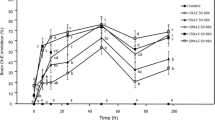Abstract
Chlorpyrifos was tested for its influence on thein vitro andin vivo brain acetylcholinesterase (AChE) activity ofFundulus heteroclitus under laboratory as well as field conditions. The concentration required for a 50% reduction in the mvitro enzyme activity (I50) was 7.2 × 10−2 mM for the parent compound and 4.1 × 10−6 mM for its oxygen analog. A 96-hr exposure of live fish to 1.0Μg/L chlorpyrifos resulted in a maximum AChE inhibition of 24%. At a concentration of 2.1Μg/L or higher, a 100% enzyme inhibition was observed after a 24-hr exposure period, followed by varying degrees of recovery during the next 24 hr. A second peak of AChE inhibition, proportional to the concentration of the insecticide, was observed 72 hr after the initial exposure and this was followed by a second phase of recovery during the next 24 hr. In spite of an initial 100% AChE inhibition at test concentrations of 2.1Μg/L and above, the fish mortality was less at lower concentration of the insecticide than at the higher levels. The 96-hr TL50 and TL5 (tolerance limit for 50% and 5% fish survival) of chlorpyrifos forF. heteroclitus were 4.7Μg/L and 12.2Μg/L, respectively. The LT50 (lethal time in which 50% of the fish died) at a concentration of 5.6Μg/L was 49.5 hr.
Fish exposed to 4 successive field applications of chlorpyrifos granules showed AChE inhibition ranging from 56 to 100% and the insecticide effect was cumulative in nature. By 24 hr after the second application, 18.6% of the treatment fish had died; live fish collected at this time showed a 96% depression of AChE activity. AChE inhibition was still evident (62%) in fish 69 days after the final application of chlorpyrifos.
Similar content being viewed by others
References
Coppage, D. L.: Organophosphate pesticides: Specific level of brain AChE inhibition related to death in sheephead minnows. Trans. Amer. Fish. Soc.101, 534 (1972).
Coppage, D.L., and E. Matthews: Short term effects of organophosphate pesticides on cholinesterases of estuarine fishes and pink shrimp. Bull. Environ. Contam. Toxicol.11, 483 (1974).
Düsch, M. E.: Determination of Dursban insecticide in water, mud, vegetation, fish, ducks, insects and crustacea. J. Agr. Food Chem.18, 178 (1970).
Fallscheer, H. O., and J. W. Cook: Studies on the conversion of some thionophosphates and a dithiophosphate toin vitro cholinesterase inhibitors. J. Ass. Offiic. Anal. Chem.39, 691 (1956).
Ferguson, D. E., D.T. Gardner, and A. L. Lindley: Toxicity of Dursban to three species of fish. Mosquito News26, 80 (1966).
Finney, D. J.: Probit analysis. A statistical treatment of a sigmoidal response curve. 2 ed., p. 318. Cambridge University Press (1952).
Fleming, W. R., K. G. Scheffel, and J. R. Linton: Studies on the gill cholinesterase activity of several cyprinodontid fishes. Comp. Biochem. Physiol.6, 205 (1962).
Gibson, J. R., J. L. Ludke, and D. E. Ferguson: Sources of error in the use of fish-brain acetylcholinesterase activity as a monitor for pollution. Bull. Environ. Contain. Toxicol.4, 17 (1969).
Henderson, C., and Q. H. Pickering: Toxicity of organic phosphorus insecticides to fish. Trans. Amer. Fish. Soc.87, 39 (1957).
Hestrin, S.: The reaction of acetylcholine and other carboxylic acid derivatives with hydroxylamine, and its analytical application. J. Biol. Chem.180, 249 (1949).
Katz, M.: Acute toxicity of some organic insecticides to three species of salmonids and to the threespine stickleback. Trans. Amer. Fish. Soc.90, 264 (1961).
Koch, H. J.: Cholinesterase and active transport of sodium chloride through the isolated gills of the crabEriocheir sinensis (M. Edw.). In J. A. Kitching (ed.): Recent developments in cell physiology. 7th Symposium of the Colston Research Society. New York: Academic Press (1954).
Ludwig, P. D., H. J. Dishburger, J. C. McNeill IV., W. O. Miller, and J. R. Rice: Biological effects and persistence of Dursban insecticide in a salt marsh habitat. J. Econ. Entomol.61, 626 (1968).
Macek, K. J., C. Hutchinson, and O. B. Cope: The effects of temperature on the susceptibility of blue gills and rainbow trout to selected pesticides. Bull. Environ. Contamin. Toxicol.4, 174 (1969).
Macek, K. J., and W. A. McAllister: Insecticide susceptibility of some common fish family representatives. Trans. Amer. Fish. Soc.99, 20 (1970).
Macek, K. J., D. F. Walsh, J. W. Hogan, and D. D. Holz: Toxicity of the insecticide Dursban to fish and aquatic invertebrates in ponds. Trans. Amer. Fish. Soc.101, 420 (1972).
Menzie, C. M.: Metabolism of pesticides. Bureau of Sport Fisheries and Wildlife, Special Scientific Report-Wildlife No. 127, Washington, D. C. (1969).
Muirhead-Thomson, R. C.: Pesticides and freshwater fauna. p. 248. New York: Academic Press (1971).
Pickering, Q. H., C. Henderson, and A. E. Lemke: Toxicity of organic phosphorus insecticides to different species of warmwater fish. Trans. Amer. Fish. Soc.91, 175 (1962).
Smith, G. N., B. S. Watson, and F. S. Fischer: The metabolism of [14C]O,O-DiethylO-(3,5,6-trichloro-2-pyridyl) phosphorothioate (Dursban) in fish. J. Econ. Entomol.59, 1464 (1966).
Stavinoha, W. B., J. A. Rieger, Jr., L. C. Ryan, and P. W. Smith: Effects of chronic poisoning by an organophosphorus cholinesterase inhibitor on acetylcholine and norepinephrine content of the brain. In R. F. Gould (ed.) Organic pesticides in the environment. p. 309. Washington, D. C.:American Chemical Society (1966).
Thirugnanam, M., and A. J. Forgash: Environmental impact of mosquito pesticides: Influence of temefos on the brain acetylcholinesterase of killifish. Environ. Physiol. Biochem.5, 451 (1975).
Weiss, C. M.: Physiological effect of organophosphorus insecticides on several species of fish. Trans. Amer. Fish. Soc.90, 143 (1961).
Author information
Authors and Affiliations
Additional information
Paper of the Journal Series, New Jersey Agricultural Experiment Station, Rutgers-The State University of New Jersey, New Brunswick, New Jersey 08903, USA. Supported by a grant from N. J. State Mosquito Commission.
Rights and permissions
About this article
Cite this article
Thirugnanam, M., Forgash, A.J. Environmental impact of mosquito pesticides: Toxicity and anticholinesterase activity of chlorpyrifos to fish in a salt marsh habitat. Arch. Environ. Contam. Toxicol. 5, 415–425 (1977). https://doi.org/10.1007/BF02220921
Issue Date:
DOI: https://doi.org/10.1007/BF02220921




